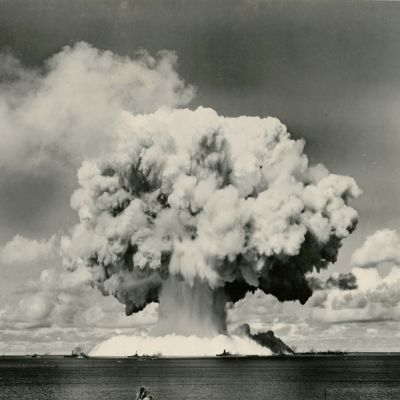Opposed by Oppenheimer: the first Bikini bombs, exploding
[Photography]
Atomic bombs: Operation Crossroads, "Able" and "Baker" events.
Published
1946
Item ID
68991
€2,400.00
Bikini, [not published], 1946. Two original photo prints. Each 25.4 x 20.6 cm.
Original photographs, made by a military observer from an aircraft and not by a monitoring camera, as most known photographs from these tests. These were the first open air atomic detonations on the Bikini Atoll. J. Robert Oppenheimer, the "father of the atomic bomb", declined an invitation to attend the test and wrote President Truman about his objections to it, arguing that any data obtained from the test could be obtained more accurately and cheaply in a laboratory. The photographs most probably come from the personal collection of John T. "Chick" Hayward (1908-1999), a decorated aviator who later became a Navy vice admiral and who participated in the Manhattan Project, which developed the atomic bomb. He was born in New York. As a youth, he was a batboy for the New York Yankees baseball team. When he was 16, he joined the Navy after being expelled from military school for disciplinary reasons and dropping out of high school. He was such an exemplary seaman that he was one of the few enlisted men accepted by the U.S. Naval Academy at Annapolis. He graduated from the U.S. Naval Academy at Annapolis in 1930. In the early part of World War II, he flew dozens of bombing missions in the South Pacific before participating in the Manhattan Project. Admiral Hayward joined the Manhattan Project at the China Lake Naval Ordnance Test Station in California in 1944. He helped develop the implosion components of the bomb dropped over Nagasaki, Japan. He was not involved in the development of the atomic bomb dropped on Hiroshima three days earlier. After the war, he went to Japan to study the aftereffects on Nagasaki and Hiroshima. In 1946, he was in charge of the first attempt to photograph a nuclear explosion on the Bikini atoll, with equipment that shot 800,000 frames per second. In the early 1950s, he helped plan atomic weapons laboratory work at Los Alamos and Sandia. He also worked on the foundation of the Livermore Laboratory program in 1952 in close collaboration with Edward Teller. Over the years, he had worked on systems for ground- and air-launched rockets and became a pioneer in the development of weapons used to fight submarines. He also commanded the first nuclear-powered task force in naval history, leading the aircraft carrier Enterprise. Admiral Hayward served as president of the Naval War College in Newport, Rhode Island, from 1966 until retiring from active duty in 1968. He later worked for General Dynamics as a vice president for international programs. His Navy decorations included two awards of the Distinguished Service Medal and the Silver Star, the Legion of Merit, the Distinguished Flying Cross and the Air Medal. These photos document the first Bikini atoll explosions, known as the Operation Crossroads, "Able" and "Baker" events. Operation Crossroads was a series of nuclear weapon tests conducted by the United States in the summer of 1946. Its purpose was to investigate the effect of nuclear weapons on naval ships. The series consisted of two detonations, each with a yield of 23 kilotons.
read more
The first photo records Test Able, which was detonated at an altitude of 520 feet (158 m) on July 1, 1946. The second photo is from Test Baker, which was detonated 90 feet (27 m) underwater on July 25, 1946. American, German, and Japanese battleships are in the foreground, earmarked for tested destruction. A third burst, Charlie, planned for 1947, was cancelled primarily because of the Navy's inability to decontaminate the target ships after the Baker test. The Crossroads tests were the fourth and fifth nuclear explosions conducted by the United States (Trinity, in the New Mexico desert was first, Hiroshima and Nagasaki were the second and third). They were the first of many nuclear tests held in the Marshall Islands, and the first to be publicly announced beforehand and observed by an invited audience, including a large press corps. Admiral Hayward was in charge of photographing the two detonations seen on these two pictures. Original file numbers, release dates and further information are printed on the print versos "IT FLIES THROUGH THE AIR WITH THE GREATEST OF HEAT - The atom bomb burst, in its test of the fleet. Looking for all the world like a giant cauliflower head suspended to an ever-stretching neck, Bikini's billowing cloud of smoke and flame was caught in its various stages of formation by a Navy patrol bomber flying just beyond range of the deadly explosion..". This remarkably poetic text on the back suggest a great admiration for these weapons of mass destruction. The photographer(s) of these were close enough to the detonation that they were exposed to radioactive contamination. "Able" was the first detonation at Bikini Atoll. It required that the entire native population be relocated, which is still controversial. They were told they could return but the island is still too radioactively contaminated to this day. Both photos are of great historical value. Very light marginal creasing, otherwise fine. Very rare. Also present are "How to photograph an atomic bomb" published by VCE, Inc in 2006 and a copy of "Bluejacket Admiral" by John T. Hayward and C.W. Borklund, Naval War College Foundation, 2000, with a nice dedication by Hayward's daughter, Victoria. The original photographs came with the book, supporting the claim that these came from the personal collection of Admiral Hayward.
read less




